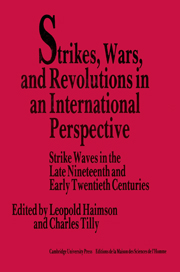 Strikes, Wars, and Revolutions in an International Perspective
Strikes, Wars, and Revolutions in an International Perspective Book contents
- Frontmatter
- Contents
- List of contributors
- Preface
- Part I Introductions
- Part II Models and realities
- Part III Workers in metal-processing enterprises in comparative perspective
- 11 From the mechanic to the metallo
- 12 Strikes of machinists in the United States, 1870–1922
- 13 The political economy of British engineering workers during the First World War
- 14 The rationalization of class struggle: strikes and strike strategy of the German Metalworkers' Union, 1891–1922
- 15 Scientific management and the changing nature of work in the St. Petersburg metalworking industry, 1900–1914
- 16 Structural processes of change and changing patterns of labor unrest: the case of the metal-processing industry in Imperial Russia, 1890–1914
- 17 Social characteristics, attitudes, and patterns of strike behavior of metalworkers in Italy during the First World War
- Part IV The effects of short-term variation
- Part V Conclusion
14 - The rationalization of class struggle: strikes and strike strategy of the German Metalworkers' Union, 1891–1922
Published online by Cambridge University Press: 25 March 2010
- Frontmatter
- Contents
- List of contributors
- Preface
- Part I Introductions
- Part II Models and realities
- Part III Workers in metal-processing enterprises in comparative perspective
- 11 From the mechanic to the metallo
- 12 Strikes of machinists in the United States, 1870–1922
- 13 The political economy of British engineering workers during the First World War
- 14 The rationalization of class struggle: strikes and strike strategy of the German Metalworkers' Union, 1891–1922
- 15 Scientific management and the changing nature of work in the St. Petersburg metalworking industry, 1900–1914
- 16 Structural processes of change and changing patterns of labor unrest: the case of the metal-processing industry in Imperial Russia, 1890–1914
- 17 Social characteristics, attitudes, and patterns of strike behavior of metalworkers in Italy during the First World War
- Part IV The effects of short-term variation
- Part V Conclusion
Summary
This study of the strikes led by the German Metalworkers' Union (Deutscher Metallarbeiter-Verband, DMV) and of this union's strategy pursues the dual goal of understanding union action on the one hand and of union interpretation of its strategies of class struggle on the other. Union action must be at the center of research about labor unions because associations of workers were perfectly able and willing to generate their own strategies and to pursue them in practice. They actively intervened in the historical process of labor conflicts rather than being driven by external forces. I start with the conviction that to deny workers and their unions the role as independent actors in a tense and contradictory environment is historically incorrect. It also withdraws dignity and responsibility from workers and their associations.
The DMV was the first German union that organized itself along the lines of an industrial union. The model of industrial unions is commonly considered to be progressive, as opposed to traditional trade unions organized along craft lines. The “modern” principle of the industrial union is stated to be the appropriate organizational form for the phase of “organized capitalism.” It is credited with having played a decisive role in the changes in the form and function experienced by the labor struggles around the turn of the century. This view is reflected in various approaches, most of which, however, are reductionist.
Existing studies of strike developments in Germany are characterized by their obvious avoidance of workers' organizations. Along with case studies of spectacular labor struggles, the major emphasis has been on quantitative analyses.
- Type
- Chapter
- Information
- Strikes, Wars, and Revolutions in an International PerspectiveStrike Waves in the Late Nineteenth and Early Twentieth Centuries, pp. 321 - 355Publisher: Cambridge University PressPrint publication year: 1989
- 1
- Cited by
